tow LEXUS IS350 2022 Owners Manual
[x] Cancel search | Manufacturer: LEXUS, Model Year: 2022, Model line: IS350, Model: LEXUS IS350 2022Pages: 440, PDF Size: 22.72 MB
Page 4 of 440
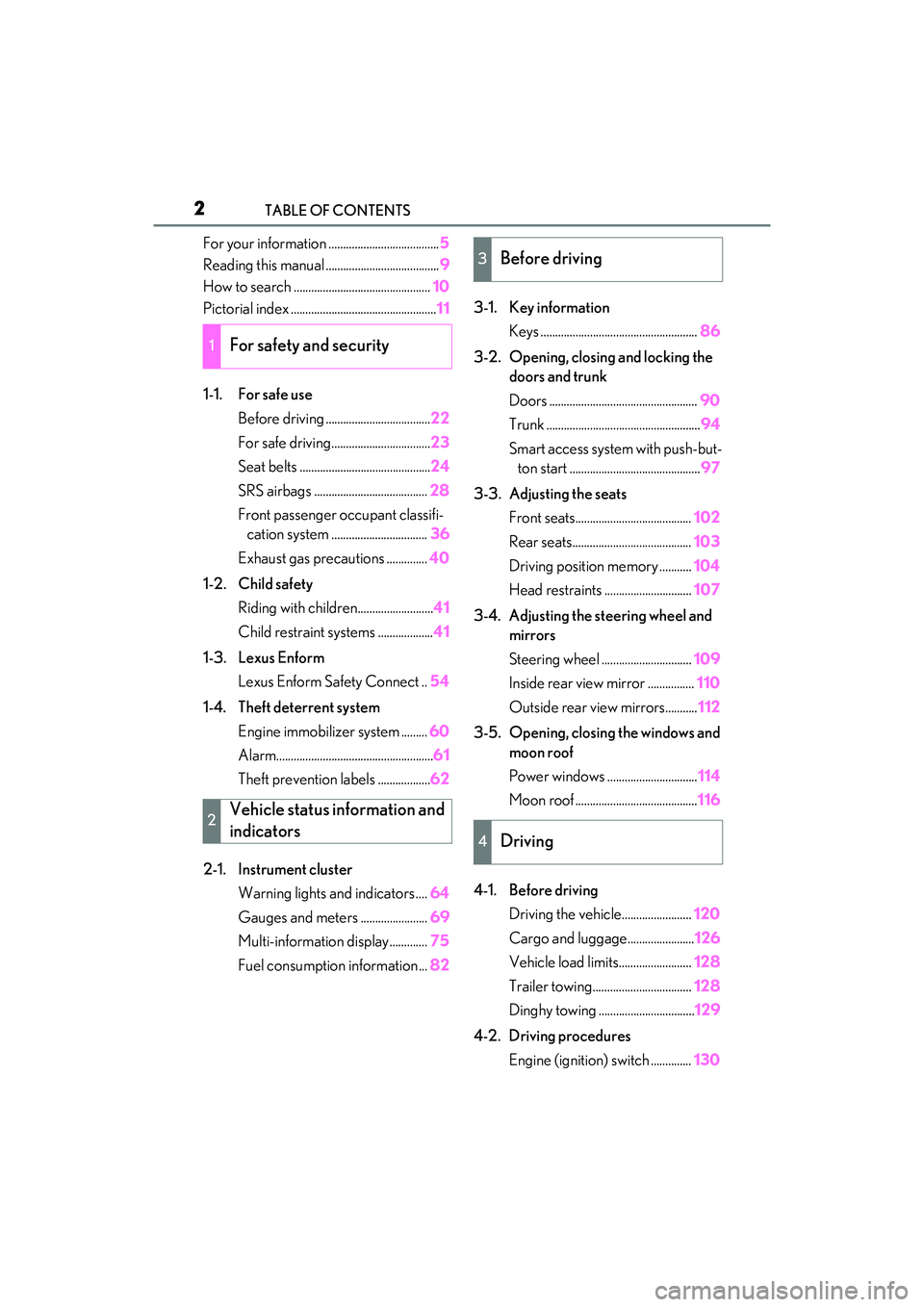
2TABLE OF CONTENTS
For your information ......................................5
Reading this manual ....................................... 9
How to search ............................................... 10
Pictorial index .................................................. 11
1-1. For safe use Before driving .................................... 22
For safe driving.................................. 23
Seat belts ............................................. 24
SRS airbags ....................................... 28
Front passenger occupant classifi- cation system ................................. 36
Exhaust gas precautions .............. 40
1-2. Child safety Riding with children.......................... 41
Child restraint systems ................... 41
1-3. Lexus Enform Lexus Enform Safety Connect .. 54
1-4. Theft deterrent system Engine immobili zer system .........60
Alarm...................................................... 61
Theft prevention labels .................. 62
2-1. Instrument cluster Warning lights and indicators .... 64
Gauges and meters ....................... 69
Multi-information display............. 75
Fuel consumption information ... 823-1. Key information
Keys ...................................................... 86
3-2. Opening, closing and locking the doors and trunk
Doors ................................................... 90
Trunk ..................................................... 94
Smart access system with push-but- ton start ............................................. 97
3-3. Adjusting the seats Front seats........................................ 102
Rear seats......................................... 103
Driving position memory ........... 104
Head restraints .............................. 107
3-4. Adjusting the steering wheel and mirrors
Steering wheel ............................... 109
Inside rear view mirror ................ 110
Outside rear view mirrors........... 112
3-5. Opening, closing the windows and moon roof
Power windows ............................... 114
Moon roof .......................................... 116
4-1. Before driving Driving the vehicle........................ 120
Cargo and luggage....................... 126
Vehicle load limits......................... 128
Trailer towing.................................. 128
Dinghy towing ................................. 129
4-2. Driving procedures Engine (ignition) switch .............. 130
1For safety and security
2Vehicle status information and
indicators
3Before driving
4Driving
Page 6 of 440
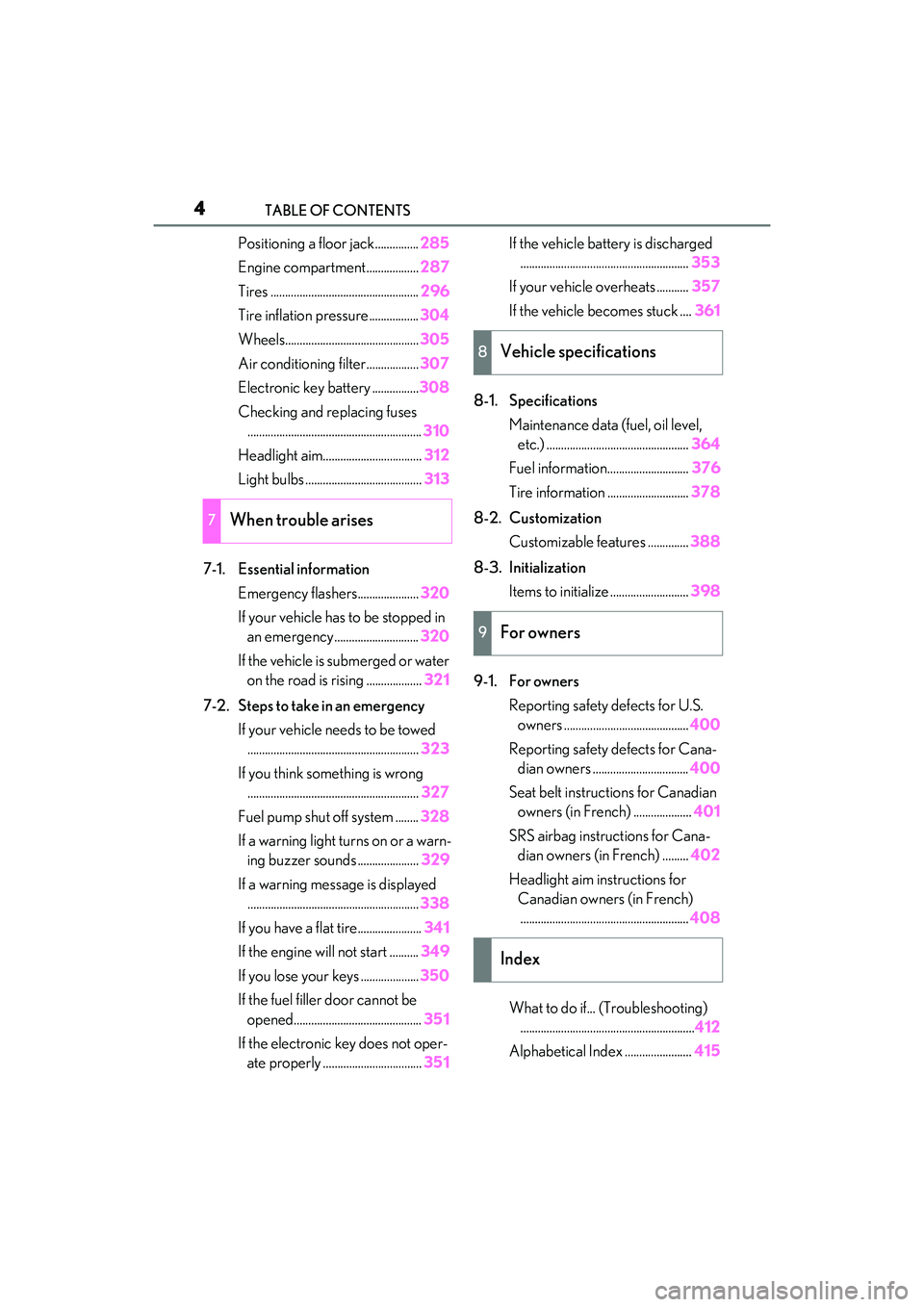
4TABLE OF CONTENTS
Positioning a floor jack...............285
Engine compartment.................. 287
Tires ................................................... 296
Tire inflation pressure................. 304
Wheels.............................................. 305
Air conditioning filter..................307
Electronic key battery ................ 308
Checking and replacing fuses ............................................................ 310
Headlight aim.................................. 312
Light bulbs ........................................ 313
7-1. Essential information Emergency flashers..................... 320
If your vehicle has to be stopped in an emergency ............................. 320
If the vehicle is submerged or water on the road is rising ................... 321
7-2. Steps to take in an emergency If your vehicle needs to be towed........................................................... 323
If you think something is wrong ........................................................... 327
Fuel pump shut off system ........ 328
If a warning light turns on or a warn- ing buzzer sounds ..................... 329
If a warning message is displayed ........................................................... 338
If you have a flat tire...................... 341
If the engine wi ll not start .......... 349
If you lose your keys .................... 350
If the fuel filler door cannot be opened............................................ 351
If the electronic key does not oper- ate properly .................................. 351If the vehicle battery is discharged
.......................................................... 353
If your vehicle overheats ........... 357
If the vehicle becomes stuck .... 361
8-1. Specifications Maintenance data (fuel, oil level, etc.) ................................................. 364
Fuel information............................ 376
Tire information ............................ 378
8-2. Customization Customizable features .............. 388
8-3. Initialization Items to initialize ........................... 398
9-1. For owners Reporting safety defects for U.S. owners ........................................... 400
Reporting safety defects for Cana- dian owners ................................. 400
Seat belt instructions for Canadian owners (in French) .................... 401
SRS airbag instructions for Cana- dian owners (in French) ......... 402
Headlight aim instructions for Canadian owners (in French)
.......................................................... 408
What to do if... (Troubleshooting) ............................................................ 412
Alphabetical Index ....................... 415
7When trouble arises
8Vehicle specifications
9For owners
Index
Page 15 of 440

13Pictorial index
■Instrument panel
Engine switch ...........................................................................................................P.130
Starting the engine/changing the modes ................................................................ P.130
Emergency stop of the engine ....................................................................................P.320
When the engine will not start..................................................................................... P.349
Warning messages ..........................................................................................................P.338
Shift lever................................................................................................................... P .134
Changing the shift position ............................................................................................ P.135
Precautions for towing ................................................................................................... P.323
When the shift lever does not move .......................................................................... P.135
Meters ......................................................................................................................... .P.69
Reading the meters/adjusting the instrume nt panel light................................... P.69
Warning lights/indicator lights ...................................................................................... P.64
When a warning light comes on ................................................................................. P.329
Multi-information display ....................................................................................... P.75
Display ........................................................................................................................ .............. P.75
When a warning message is displayed....................................................................P.338A
B
C
D
Page 28 of 440

261-1. For safe use
1To fasten the seat belt, push the
plate into the buckle until a click
sound is heard.
2 To release the seat belt, press the
release button .
■Emergency locking retractor (ELR)
The retractor will lock the belt during a sud-
den stop or on impact. It may also lock if you
lean forward too quickly. A slow, easy
motion will allow the belt to extend so that
you can move around fully.
■Automatic locking retractor (ALR)
When a passenger’s shoulder belt is com-
pletely extended and then retracted even
slightly, the belt is lock ed in that position and
cannot be extended. This feature is used to
hold a child restraint system (CRS) firmly. To
free the belt again, fully retract the belt and
then pull the belt out once more. ( P.41)
■After the rear center seat belt has been
used
Stow the buckle as shown.
1 Push the seat belt shoulder anchor
down while pressing the release
button .
2 Push the seat belt shoulder anchor
up.
Move the height adjuster up and down as
needed until you hear a click.
NOTICE
■When using a seat belt extender
When releasing the se at belt, press on
the buckle release button on the
extender, not on the seat belt.
This helps prevent damage to the vehicle
interior and the extender itself.
Fastening and releasing the seat
belt
A
Adjusting the seat belt shoulder
anchor height (front seats)
WARNING
■Adjustable shoulder anchor
Always make sure the shoulder belt is
positioned across the center of your
shoulder. The belt should be kept away
from your neck, but not falling off your
shoulder. Failure to do so could reduce
the amount of protection in an accident
and cause death or serious injuries in the
event of a sudden stop, sudden swerve or
accident.
A
Page 35 of 440
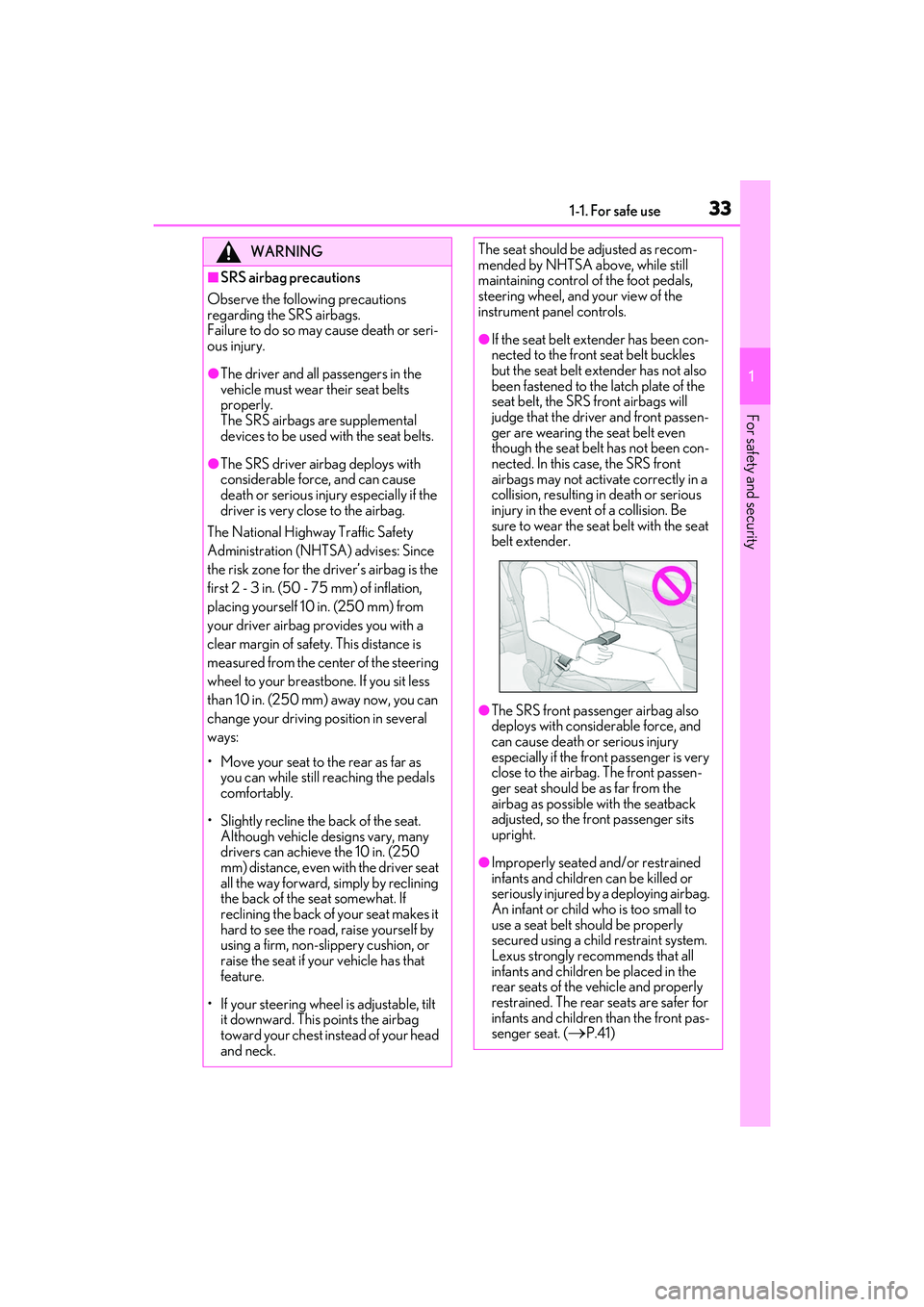
331-1. For safe use
1
For safety and security
WARNING
■SRS airbag precautions
Observe the following precautions
regarding the SRS airbags.
Failure to do so may cause death or seri-
ous injury.
●The driver and all passengers in the
vehicle must wear their seat belts
properly.
The SRS airbags are supplemental
devices to be used with the seat belts.
●The SRS driver airbag deploys with
considerable force, and can cause
death or serious injury especially if the
driver is very close to the airbag.
The National Highway Traffic Safety
Administration (NHT SA) advises: Since
the risk zone for the dr iver’s airbag is the
first 2 - 3 in. (50 - 75 mm) of inflation,
placing yourself 10 in. (250 mm) from
your driver airbag provides you with a
clear margin of safety. This distance is
measured from the center of the steering
wheel to your breastbone. If you sit less
than 10 in. (250 mm) away now, you can
change your driving position in several
ways:
• Move your seat to the rear as far as you can while still reaching the pedals
comfortably.
• Slightly recline the back of the seat. Although vehicle designs vary, many
drivers can achieve the 10 in. (250
mm) distance, even with the driver seat
all the way forward, simply by reclining
the back of the seat somewhat. If
reclining the back of your seat makes it
hard to see the road, raise yourself by
using a firm, non-slip pery cushion, or
raise the seat if your vehicle has that
feature.
• If your steering wheel is adjustable, tilt it downward. This points the airbag
toward your chest instead of your head
and neck.
The seat should be adjusted as recom-
mended by NHTSA above, while still
maintaining control of the foot pedals,
steering wheel, and your view of the
instrument panel controls.
●If the seat belt extender has been con-
nected to the front seat belt buckles
but the seat belt extender has not also
been fastened to the latch plate of the
seat belt, the SRS front airbags will
judge that the driver and front passen-
ger are wearing the seat belt even
though the seat belt has not been con-
nected. In this case, the SRS front
airbags may not activate correctly in a
collision, resulting in death or serious
injury in the event of a collision. Be
sure to wear the seat belt with the seat
belt extender.
●The SRS front passenger airbag also
deploys with consid erable force, and
can cause death or serious injury
especially if the front passenger is very
close to the airbag. The front passen-
ger seat should be as far from the
airbag as possible with the seatback
adjusted, so the front passenger sits
upright.
●Improperly seated and/or restrained
infants and children can be killed or
seriously injured by a deploying airbag.
An infant or child who is too small to
use a seat belt should be properly
secured using a child restraint system.
Lexus strongly recommends that all
infants and children be placed in the
rear seats of the vehicle and properly
restrained. The rear seats are safer for
infants and children than the front pas-
senger seat. (
P.41)
Page 36 of 440
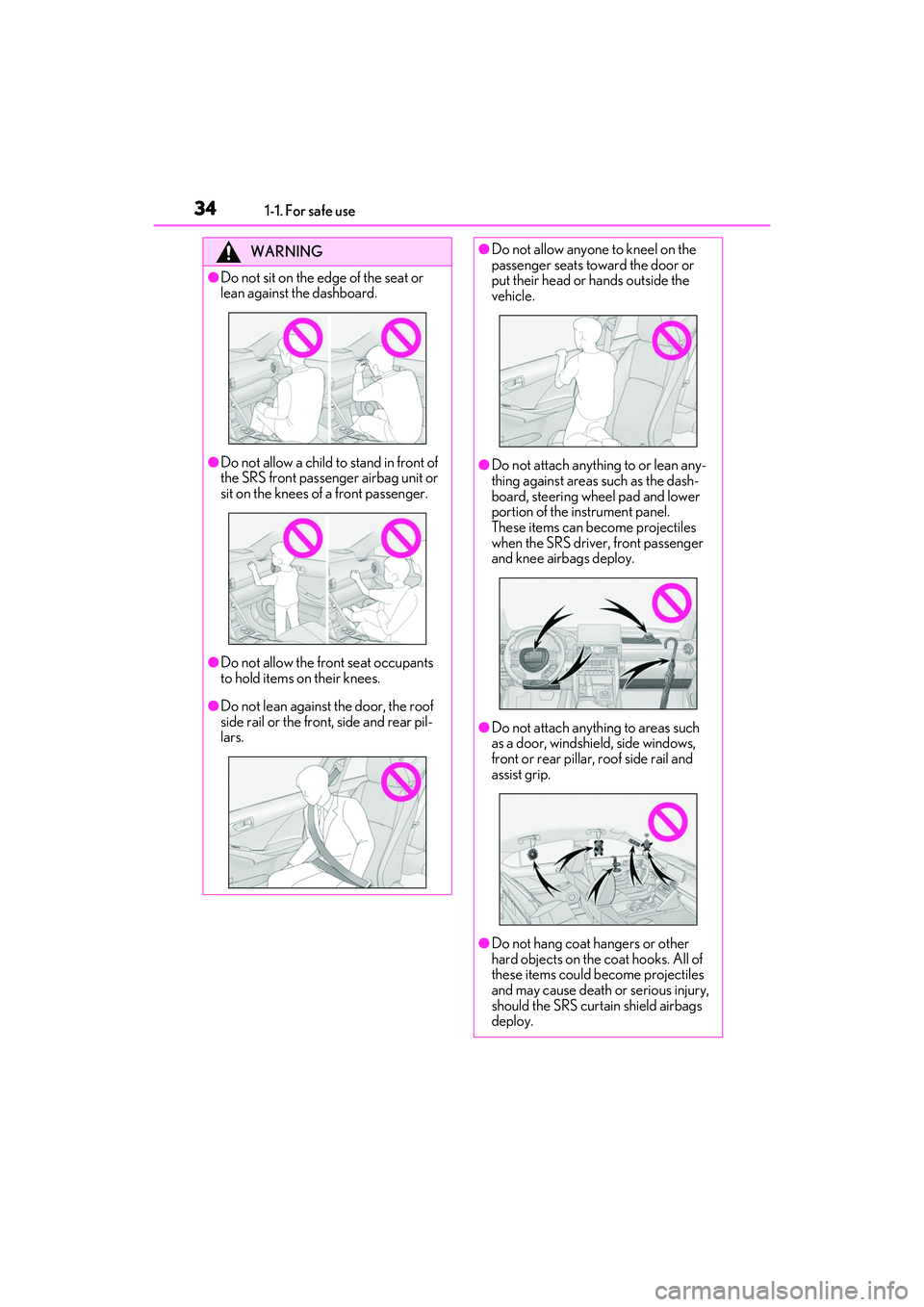
341-1. For safe use
WARNING
●Do not sit on the edge of the seat or
lean against the dashboard.
●Do not allow a child to stand in front of
the SRS front passenger airbag unit or
sit on the knees of a front passenger.
●Do not allow the front seat occupants
to hold items on their knees.
●Do not lean against the door, the roof
side rail or the front, side and rear pil-
lars.
●Do not allow anyone to kneel on the
passenger seats toward the door or
put their head or hands outside the
vehicle.
●Do not attach anything to or lean any-
thing against areas such as the dash-
board, steering wheel pad and lower
portion of the instrument panel.
These items can become projectiles
when the SRS driver, front passenger
and knee airbags deploy.
●Do not attach anything to areas such
as a door, windshie ld, side windows,
front or rear pillar, roof side rail and
assist grip.
●Do not hang coat hangers or other
hard objects on the coat hooks. All of
these items could become projectiles
and may cause death or serious injury,
should the SRS curtain shield airbags
deploy.
Page 50 of 440
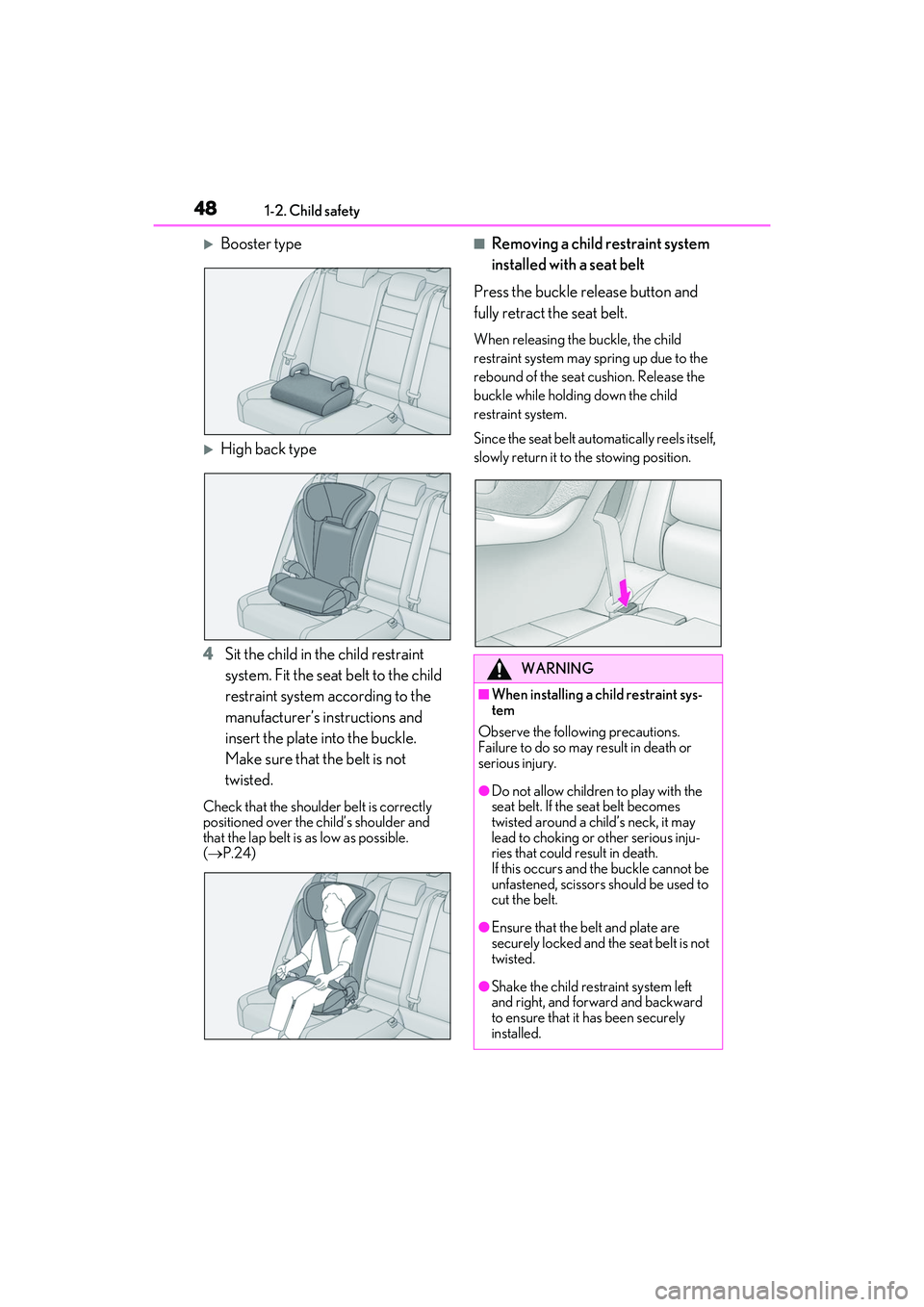
481-2. Child safety
Booster type
High back type
4 Sit the child in the child restraint
system. Fit the seat belt to the child
restraint system according to the
manufacturer’s in structions and
insert the plate into the buckle.
Make sure that the belt is not
twisted.
Check that the shoulder belt is correctly
positioned over the child’s shoulder and
that the lap belt is as low as possible.
( P.24)
■Removing a child restraint system
installed with a seat belt
Press the buckle release button and
fully retract the seat belt.
When releasing the buckle, the child
restraint system may sp ring up due to the
rebound of the seat cushion. Release the
buckle while holding down the child
restraint system.
Since the seat belt auto matically reels itself,
slowly return it to the stowing position.
WARNING
■When installing a child restraint sys-
tem
Observe the following precautions.
Failure to do so may result in death or
serious injury.
●Do not allow children to play with the
seat belt. If the seat belt becomes
twisted around a child’s neck, it may
lead to choking or other serious inju-
ries that could result in death.
If this occurs and the buckle cannot be
unfastened, scissors should be used to
cut the belt.
●Ensure that the belt and plate are
securely locked and the seat belt is not
twisted.
●Shake the child rest raint system left
and right, and forward and backward
to ensure that it has been securely
installed.
Page 60 of 440
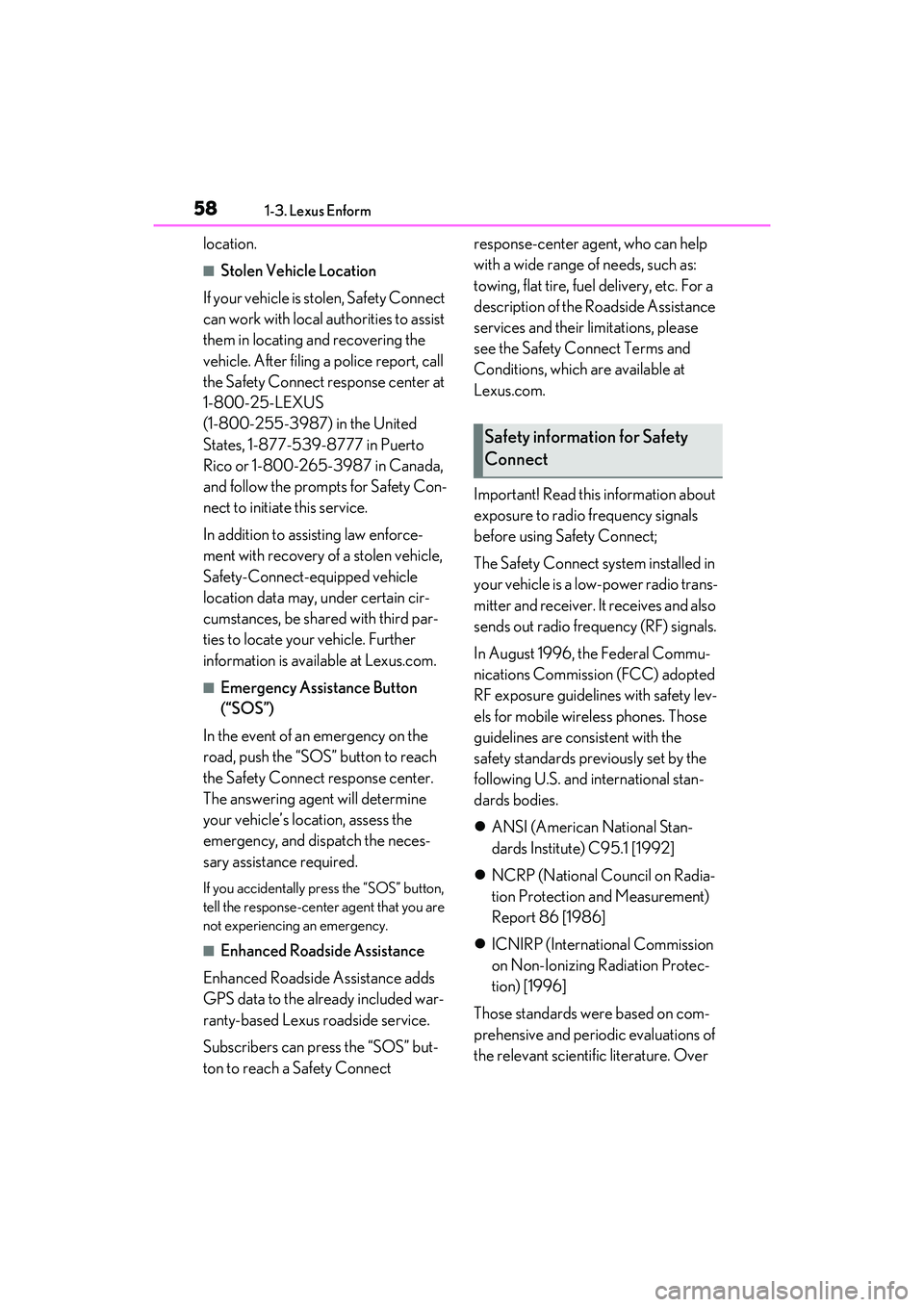
581-3. Lexus Enform
location.
■Stolen Vehicle Location
If your vehicle is stolen, Safety Connect
can work with local authorities to assist
them in locating and recovering the
vehicle. After filing a police report, call
the Safety Connect response center at
1-800-25-LEXUS
(1-800-255-3987) in the United
States, 1-877-539-8777 in Puerto
Rico or 1-800-265- 3987 in Canada,
and follow the prompts for Safety Con-
nect to initiate this service.
In addition to assisting law enforce-
ment with recovery of a stolen vehicle,
Safety-Connect-equipped vehicle
location data may, under certain cir-
cumstances, be shared with third par-
ties to locate your vehicle. Further
information is available at Lexus.com.
■Emergency Assistance Button
(“SOS”)
In the event of an emergency on the
road, push the “SOS” button to reach
the Safety Connect response center.
The answering agent will determine
your vehicle’s location, assess the
emergency, and dispatch the neces-
sary assistance required.
If you accidentally press the “SOS” button,
tell the response-center agent that you are
not experiencing an emergency.
■Enhanced Roadside Assistance
Enhanced Roadside Assistance adds
GPS data to the already included war-
ranty-based Lexus roadside service.
Subscribers can press the “SOS” but-
ton to reach a Safety Connect response-center agent, who can help
with a wide range of needs, such as:
towing, flat tire, fuel delivery, etc. For a
description of the Roadside Assistance
services and their limitations, please
see the Safety Connect Terms and
Conditions, which are available at
Lexus.com.
Important! Read this information about
exposure to radio frequency signals
before using Safety Connect;
The Safety Connect system installed in
your vehicle is a low-power radio trans-
mitter and receiver. It receives and also
sends out radio frequency (RF) signals.
In August 1996, the Federal Commu-
nications Commission (FCC) adopted
RF exposure guidelines with safety lev-
els for mobile wireless phones. Those
guidelines are consistent with the
safety standards previously set by the
following U.S. and international stan-
dards bodies.
ANSI (American National Stan-
dards Institute) C95.1 [1992]
NCRP (National Council on Radia-
tion Protection and Measurement)
Report 86 [1986]
ICNIRP (International Commission
on Non-Ionizing Radiation Protec-
tion) [1996]
Those standards were based on com-
prehensive and periodic evaluations of
the relevant scientific literature. Over
Safety information for Safety
Connect
Page 100 of 440

983-2. Opening, closing and locking the doors and trunk
●When an interior alarm sounds continu-
ously
■If a warning message is displayed indi-
cating that there is a malfunction in the
smart access system with push-button
start
An attempt was made to lock the doors
using the smart access system with
push-button start while the electronic key
was still inside the vehicle. Retrieve the elec-
tronic key from the vehicle and lock the
doors again.
■Battery-saving function
The battery-saving fu nction will be acti-
vated in order to prevent the electronic key
battery and the vehicle battery from being
discharged while the vehicle is not in opera-
tion for a long time.
●In the following situations, the smart
access system with push-button start may
take some time to unlock the doors.
• The electronic key has been left within approximately 6 ft. (2 m) of the outside of
the vehicle for 10 minutes or longer.
• The smart access system with push-but- ton start has not been used for 5 days or
longer.
●If the smart access system with push-but-
ton start has not been used for 14 days or
longer, the doors cannot be unlocked at
any door except the driver’s door. In this
case, hold the driver’s door handle, or use
the wireless remote control or mechani-
cal key, to unlock the doors.
■Electronic Key Battery-Saving Function
When battery-saving mode is set, battery
depletion is minimized by stopping the elec-
tronic key from receiving radio waves.
Press twice while pressing and holding
. Confirm that the electronic key indica-
tor flashes 4 times.
While the battery-saving mode is set, the
smart access system with push-button start
cannot be used. To cancel the function,
press any of the electronic key buttons.
■Conditions affecting operation
The smart access system with push-button
start uses weak radio waves. In the following
situations, the communication between the
electronic key and the vehicle may be
affected, preventing the smart access sys-
tem with push-button start, wireless remote
control and engine immobilizer system
from operating properly. (Ways of coping:
P.351)
●When the electronic key battery is
depleted
●Near a TV tower, electric power plant,
SituationCorrection
procedure
An attempt was made to lock the vehicle while a door was open.Close all of the doors and lock the doors again.
The trunk was closed
while the electronic key was still inside the trunk and all the doors were locked.Retrieve the
electronic key
from the trunk and close the trunk lid.
SituationCorrection procedure
The engine switch was
turned to ACCESSORY mode while the driver’s door was open (The
driver’s door was opened when the engine switch was in ACCESSORY mode).
Turn the engine switch off and close the
driver’s door.
The engine switch was turned off while the
driver’s door was open.Close the
driver’s door.
Page 109 of 440
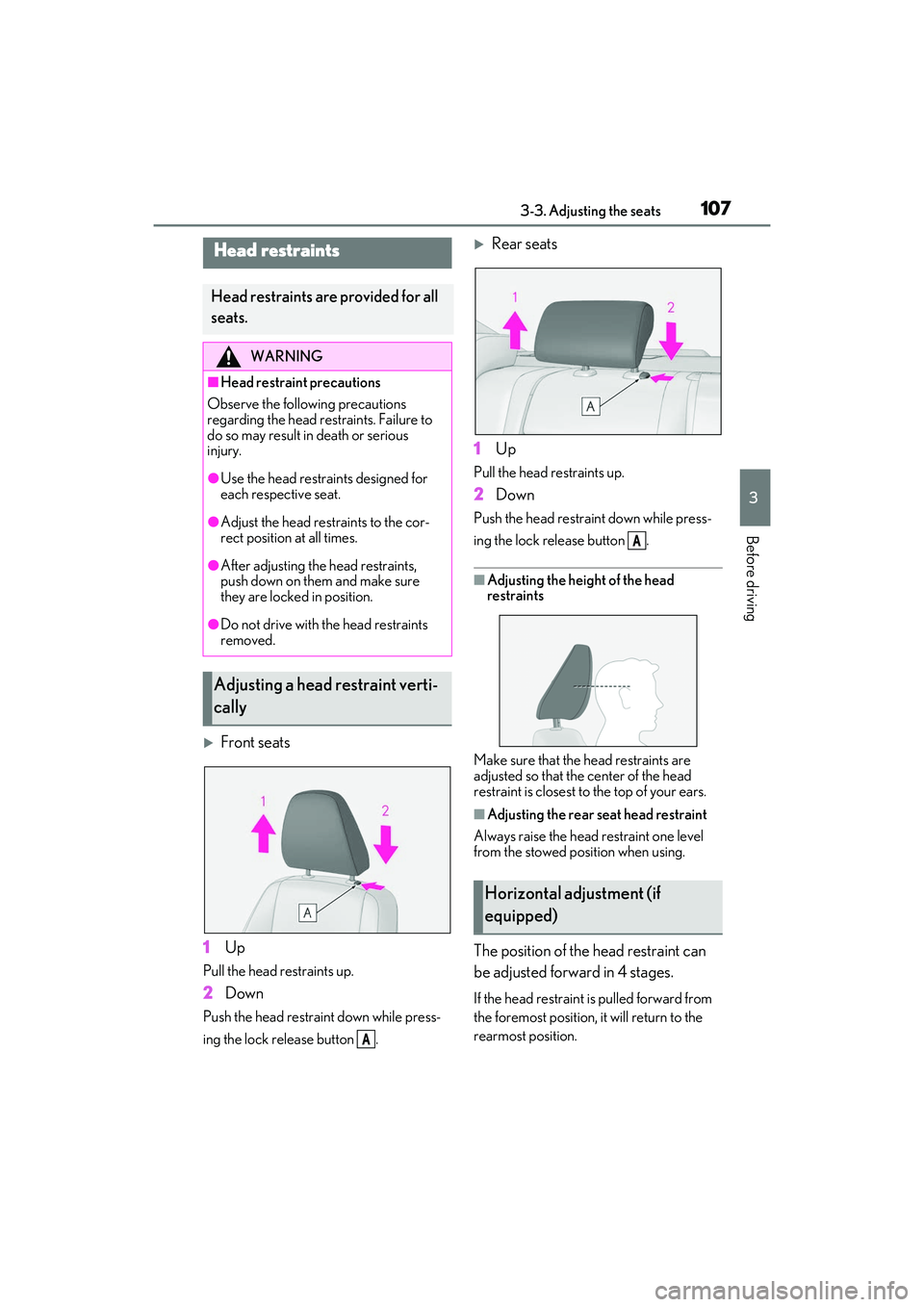
1073-3. Adjusting the seats
3
Before driving
Front seats
1 Up
Pull the head restraints up.
2Down
Push the head restraint down while press-
ing the lock release button .
Rear seats
1 Up
Pull the head restraints up.
2Down
Push the head restra int down while press-
ing the lock release button .
■Adjusting the heig ht of the head
restraints
Make sure that the head restraints are
adjusted so that the center of the head
restraint is closest to the top of your ears.
■Adjusting the rear seat head restraint
Always raise the head restraint one level
from the stowed position when using.
The position of the head restraint can
be adjusted forward in 4 stages.
If the head restraint is pulled forward from
the foremost position, it will return to the
rearmost position.
Head restraints
Head restraints are provided for all
seats.
WARNING
■Head restraint precautions
Observe the following precautions
regarding the head restraints. Failure to
do so may result in death or serious
injury.
●Use the head restraints designed for
each respective seat.
●Adjust the head restraints to the cor-
rect position at all times.
●After adjusting the head restraints,
push down on them and make sure
they are locked in position.
●Do not drive with the head restraints
removed.
Adjusting a head restraint verti-
cally
A
Horizontal adjustment (if
equipped)
A